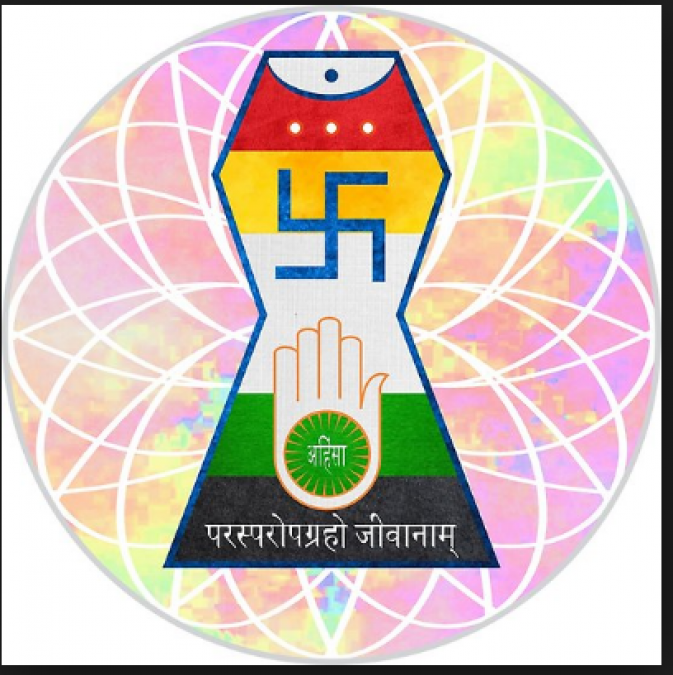
The early Jains contemplated the nature of the Earth and the Universe, and developed a detailed hypothesis on the various aspects of astronomy and cosmology. The Jain emblem is composed of many fundamental concepts and symbols. The outline of the image represents the universe as described in Jain scriptures. It consists of three Loks, or realms. The upper portion indicates Urdhava Lok, or heaven, the middle portion indicates Madhya Lok, or material world, and the lower portion indicates Adho Lok, or hell. The Upper World (Urdhva Loka) is divided into different abodes and are the realms of the heavenly beings (demi-gods), who are non-liberated souls. The Upper World is divided into 16 Devalokas, nine Graiveyaka, nine Anudish and five Anuttar abodes. The 16 Devaloka abodes are Saudharma, Aishana, Sanatkumara, Mahendra, Brahma, Brahmottara, Lantava, Kapishta, Shukra, Mahashukra, Shatara, Sahasrara, Anata, Pranata, Arana and Achyuta. The nine Graiveyak abodes are Sudarshan, Amogh, Suprabuddha,Yashodhar, Subhadra, Suvishal, Sumanas, Saumanas and Pritikar. The nine Anudish are Aditya, Archi, Archimalini, Vair, Vairochan, Saum, Saumrup, Ark and Sphatik. The five Anuttar are Vijaya, Vaijayanta, Jayanta, Aparajita and Sarvarthasiddhi...
Here it is to be noted that the 16 heavens in Devalokas are also known as Kalpas and the rest are called Kalpatit. Those living in Kalpatit are called Ahamindra and are equal in grandeur. There is increase with regard to the lifetime, influence of power, happiness, lumination of body, purity in thought - colouration, capacity of the senses and range of clairvoyance in heavenly beings residing in the higher abodes. But there is a decrease regarding the motion, stature, attachment and pride.
The higher groups, dwelling in nine Greveyak and five Anutar Viman, are independent and dwell in their own vehicles. The anuttara souls attain liberation within one or two lifetimes. The lower groups, organised like earthly kingdoms - comprises the ruler (Indra), counselors, guards, queens, followers, armies, etc.
Above the Anutar vimans, at the apex of the universe, is the Siddhasila, the realm of the liberated souls, also known as the Siddhas, the perfected omniscient and blissful beings. These souls are venerated by the Jains. Madhya Loka, at the centre of the Universe, consists of 900 yojans above and 900 yojans below the earth's surface. It is inhabited by: 1. Jyotishka Devas, the luminous gods - who stay between 790-900 yojans above the earth 2.Humans and Tiryanch (animals, birds, plants) reside on the surface 3. Vyantar Devas (intermediary gods) live 100 yojans below the ground level 4. Finally, lies a place beyond the three worlds
also read Why people clap during worshiping God? Know the fact here
The semi-circular top portion symbolizes Siddhashila, a zone beyond the three realms. All the liberated bodiless souls or Siddhas are belived to reside on this forever, having been liberated from the cycle of life and death. The three dots on the top, beneath the semi-circle, symbolise the Tri Ratna or three jewels of wisdom: Samyak Darshan (right belief), Samyak Gyan (right knowledge) and Samyak Charitra (right conduct). It is these Tri Ratna which help every soul to get moksha, or liberation from the cycle of life and death. In the top portion, the four arms of the Swastika symbolise the four gatis or destinies which await all souls. Narak is a demon, Triyanch is an animal, Manushya is a human and Dev is an angel. It reflects the perpetual nature of the Universe in the Madhya Lok or material world, where a creature is destined to one of these states based on their karma, or deeds.
The Swastika also represents the four columns of the Jain Sangh: Sadhus, Sadhvis, Shravaks and Shravikas – or monks, nuns, female and male laymen. It also represents the four characteristics of the soul: infinite knowledge (Anant Gyan), infinite perception (Anant Darshan), infinite happiness (Anant Sukh) and infinite energy (Anant Virya).
The symbol of hand in the lower portion shows fearlessness and symbolizes the feeling of Ahimsa (non-violence) towards all the creatures in this world. The circle in the middle of the hand symbolizes Samasara (reincarnation cycle) and the 24 spokes represent the preachings from the 24 Tirthankars, which can be used to liberate a soul from the cycle of reincarnation. The meaning of the mantra at the bottom - Parasparopagraho Jivanam - means "Live and Let Live" - in short, that all creatures should help one another. In short, the Jain emblem represents many important concepts to show the path to enlightenment by following the basic principles of ahimsa (non-violence), tri ratna (right belief, right knowledge and right conduct) and parasparopagraho jivanam (helping others).
also read Don't keep these things in Temple of the house otherwise may face loss